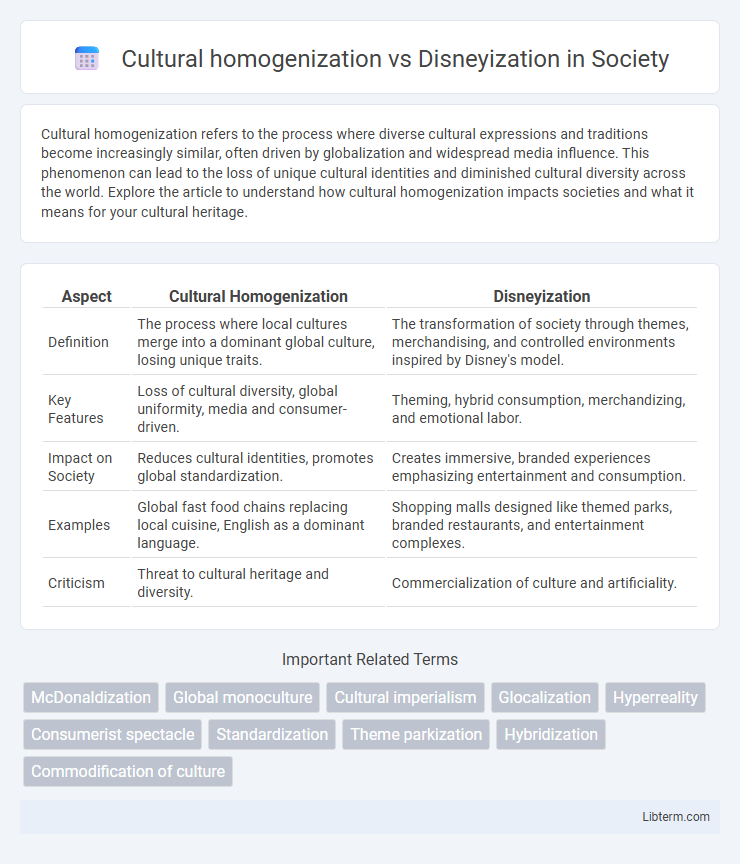Cultural homogenization refers to the process where diverse cultural expressions and traditions become increasingly similar, often driven by globalization and widespread media influence. This phenomenon can lead to the loss of unique cultural identities and diminished cultural diversity across the world. Explore the article to understand how cultural homogenization impacts societies and what it means for your cultural heritage.
Table of Comparison
| Aspect | Cultural Homogenization | Disneyization |
|---|---|---|
| Definition | The process where local cultures merge into a dominant global culture, losing unique traits. | The transformation of society through themes, merchandising, and controlled environments inspired by Disney's model. |
| Key Features | Loss of cultural diversity, global uniformity, media and consumer-driven. | Theming, hybrid consumption, merchandizing, and emotional labor. |
| Impact on Society | Reduces cultural identities, promotes global standardization. | Creates immersive, branded experiences emphasizing entertainment and consumption. |
| Examples | Global fast food chains replacing local cuisine, English as a dominant language. | Shopping malls designed like themed parks, branded restaurants, and entertainment complexes. |
| Criticism | Threat to cultural heritage and diversity. | Commercialization of culture and artificiality. |
Understanding Cultural Homogenization
Cultural homogenization refers to the process where diverse cultural expressions and identities become uniform due to globalization, often diluting local customs and traditions. This phenomenon contrasts with Disneyization, which involves the commodification and theming of culture to create sanitized, entertainment-focused experiences. Understanding cultural homogenization is crucial for recognizing the impacts of global media, multinational corporations, and standardized consumer culture on diminishing cultural diversity worldwide.
Defining Disneyization in Contemporary Culture
Disneyization in contemporary culture refers to the process where cultural spaces and experiences are transformed to resemble the sanitized, entertainment-driven, and consumption-oriented model pioneered by Disney theme parks. This phenomenon emphasizes theming, hybrid consumption, merchandising, and emotional labor, leading to standardized cultural products that can diminish local uniqueness. Unlike cultural homogenization, which results in global uniformity due to external influences, Disneyization actively packages and markets culture into commodified, enjoyable spectacles designed for mass appeal.
Historical Origins of Cultural Homogenization
Cultural homogenization traces its historical origins to colonial expansion and globalization, where dominant powers imposed their languages, customs, and economic systems on diverse societies. This process accelerated with industrialization and mass communication, facilitating the widespread adoption of similar cultural traits across the globe. Unlike Disneyization, which commodifies culture through themed entertainment and consumption patterns, cultural homogenization involves deeper, systemic changes to social practices and identities.
The Four Dimensions of Disneyization
Cultural homogenization refers to the reduction of cultural diversity through the global spread of dominant cultural elements, often leading to uniformity in cultural expressions. Disneyization, characterized by four key dimensions--merchandising, theming, dedifferentiation of consumption, and emotional labor--transforms cultural experiences into immersive, commodified entertainment. These dimensions drive a shift where local cultural identities are reshaped into standardized, consumable formats, reflecting a distinctive commercial logic rather than mere cultural uniformity.
Causes and Drivers of Cultural Homogenization
Globalization, technological advances, and mass media serve as primary drivers of cultural homogenization, promoting the widespread adoption of dominant cultural traits. The proliferation of multinational corporations, particularly media giants like Disney, accelerates the spread of standardized cultural products and entertainment formats worldwide. Consumerism and urbanization further reinforce uniform cultural preferences by encouraging lifestyles centered around global brands and shared cultural experiences.
Disneyization as a Globalization Strategy
Disneyization as a globalization strategy involves the standardization and commodification of culture through theme parks, merchandise, and media, creating a uniform consumer experience worldwide. Unlike cultural homogenization, which often implies the loss of cultural diversity, Disneyization strategically blends global cultural elements with entertainment, consumption, and themed environments to attract diverse markets while maintaining brand consistency. This approach facilitates cultural globalization by transforming local cultures into globally recognizable and marketable formats, reinforcing Disney's global cultural and economic influence.
Impacts on Local Traditions and Identities
Cultural homogenization often leads to the erosion of local traditions as global media and commercial influences standardize cultural expressions, diminishing unique identities. Disneyization transforms cultural spaces into themed environments that prioritize entertainment and consumerism, which can commodify and distort authentic local customs. Both phenomena challenge the preservation of cultural heritage by substituting diverse practices with uniform, market-driven experiences.
Media, Consumerism, and the Spread of Uniformity
Cultural homogenization in media promotes the spread of uniformity by disseminating similar narratives and values across global platforms, reducing cultural diversity. Disneyization intensifies consumerism through themed entertainment and commodification of culture, creating predictable and standardized experiences. Both processes contribute to a global landscape where unique cultural identities are overshadowed by dominant, market-driven media and consumer patterns.
Resistance and Alternatives to Homogenization
Resistance to cultural homogenization manifests through grassroots movements that celebrate local traditions, languages, and indigenous knowledge systems, countering the pervasive influence of Disneyization's standardized global entertainment model. Communities actively foster alternative cultural expressions by supporting independent art, regional festivals, and authentic storytelling that preserve diverse identities against the commodification of culture. Digital platforms and education also empower marginalized groups to reclaim narratives, promoting pluralism and resilience in the face of homogenizing forces.
Cultural Homogenization vs Disneyization: Key Differences and Intersections
Cultural homogenization refers to the process whereby local cultures lose their distinctiveness due to the pervasive influence of dominant global cultures, often driven by globalization and media proliferation. Disneyization, a specific form of cultural homogenization, characterizes the commodification and theming of cultural experiences based on Disney-style principles such as theming, merchandising, and controlled environments. While cultural homogenization broadly erodes cultural diversity, Disneyization intersects by transforming cultural spaces into sanitized, commercialized entertainment, blending global uniformity with scripted consumer experiences.
Cultural homogenization Infographic

 libterm.com
libterm.com